
The Distinguished Order of the Golden Fleece is a Catholic order of chivalry founded in Bruges by Philip the Good, Duke of Burgundy, in 1430, to celebrate his marriage to Isabella of Portugal. Today, two branches of the order exist, namely the Spanish and the Austrian Fleece; the current grand masters are King Felipe VI of Spain and Karl von Habsburg, head of the House of Habsburg-Lorraine, respectively. The Grand Chaplain of the Austrian branch is Cardinal Christoph Schönborn, Archbishop of Vienna.

Philip III the Good ruled as Duke of Burgundy from 1419 until his death in 1467. He was a member of a cadet line of the Valois dynasty, to which all 15th-century kings of France belonged. During his reign, the Burgundian State reached the apex of its prosperity and prestige, and became a leading centre of the arts.

Jean le Fèvre de Saint-Remy or Jean Lefebvre de Saint-Remy born in Abbeville, was a Burgundian chronicler during the Hundred Years' War and lord (seigneur) of Saint Remy, la Vacquerie, Avesnes and Morienne. He is also known by the formal title of authority Toison d'or because he served as the King of Arms to the Order of the Golden Fleece.

Jacques de Lalaing (1421–1453), perhaps the most renowned knight of Burgundy in the 15th century, was reportedly one of the best medieval tournament fighters of all time. A Walloon knight, he began his military career in the service of Adolph I, Duke of Cleves, but was quickly noticed by Philip the Good, Duke of Burgundy by whom he was knighted and whom he went on to serve. Jacques, known as the "Bon Chevalier" due to his military prowess in tournaments and battles, became the most famous Burgundian knight of his time, and was well known throughout Europe as one of the best medieval tournament fighters. Jacques was inducted into the prestigious Burgundian chivalric order, the Order of the Golden Fleece, in 1451. Jacques' deeds in tournaments and battles were recorded in the Livre des Faits de Jacques Lalaing attributed mainly to the Burgundian chroniclers Jean Le Fevre de Saint-Remy, Georges Chastellain, and the herald Charolais. Throughout his life, Jacques was entrusted by the Duke of Burgundy to serve in delegations to the King of France and the Pope, as well as with the suppression of the Revolt of Ghent in 1453.

An order of chivalry, order of knighthood, chivalric order, or equestrian order is an order of knights, typically founded during or inspired by the original Catholic military orders of the Crusades and paired with medieval concepts of ideals of chivalry.

Jacques of Savoy, Count of Romont was a member of the House of Savoy and military commander during the Burgundian Wars.

Jean-Baptiste du Casse was a French naval officer, privateer, slave trader and colonial administrator who served as the first governor of Saint-Domingue from 1691 to 1700. Born on 2 August 1646 in Saubusse, France to a Huguenot family, du Casse enlisted in the French merchant navy before joining the French East India Company and the Compagnie du Sénégal. He subsequently enlisted in the French Navy and took part in several victorious expeditions during the Nine Years' War in the West Indies and South America.

The Château de Châteauneuf, also known as the Château de Châteauneuf-en-Auxois, is a 15th-century fortress in the commune of Châteauneuf, 43 km from Dijon, in the Côte-d'Or département of France. It is a vast stone building, 75 metres in length and 35 metres broad, situated on a rocky outcrop 475 metres above the surrounding plains. It dominates the valley of Canal de Bourgogne.

Ferry de Clugny, Cardinal and Bishop of Tournai was a highly placed statesman and ecclesiastic in the service of the Dukes of Burgundy.

Jean de la Trémoille, seigneur of Jonvelle, was Grand Master and Grand Chamberlain to the dukes of Burgundy John the Fearless and Philip the Good. He was the son of Guy and Marie de Sully, Princess of Boisbelle and Countess of Guînes. On 17 July 1424 he married Jacqueline d'Amboise, daughter of Ingerger II and Jeanne de Craon.
Pierre Monier or Mosnier was a French painter and author.
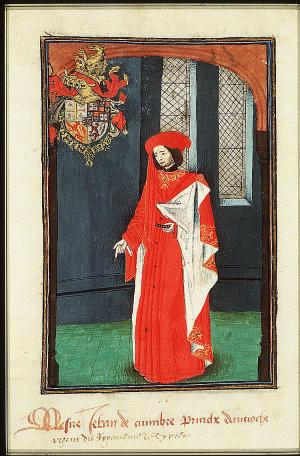
John, Prince of Antioch was the second son of Infante Peter, Duke of Coimbra, and Isabella of Urgell, Duchess of Coimbra.
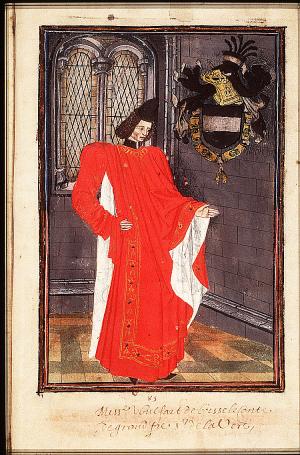
Wolfert VI of Borselen was stadtholder of Holland, Friesland, and Zeeland, Admiral of the Netherlands outside Flanders, and Lord of Veere.
Most of the members of the Capetian dynasty bore a version of the arms of France. The arms of France were adopted by the Capetian kings only in the twelfth century. Consequently, the cadet branches that had branched off in earlier periods bore entirely different arms.
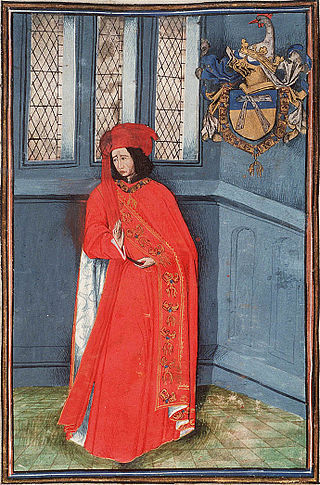
Jean de Villiers, Seigneur of L'Isle-Adam was a French nobleman and military commander who fought in the Hundred Years' War. As a supporter of the Duke of Burgundy, he fought on both sides of the conflict – English and French. He was a Marshal of France and a founding member of the knightly Order of the Golden Fleece.
La toison d'or, soon revised as Médée à Colchos ou La toison d'or, is a French-language opera in three acts by the composer Johann Christoph Vogel. It was first performed at the Académie Royale de Musique on 5 September 1786, "some years after its completion". The libretto, by Philippe Desriaux, is based on the legend of Jason and the Golden Fleece.
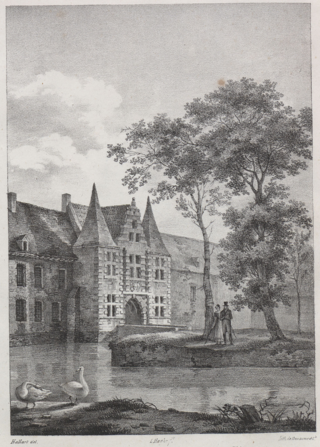
Jean IIIde Werchin, called the Good, was a knight errant and poet from the County of Hainaut in the Holy Roman Empire. In 1383 his father died and he inherited the baronies of Werchin, Walincourt and Cysoing, as well as the hereditary office of seneschal of Hainaut, which had been in his family since about 1234.

Brimeu is a noble family, some members belonging to the Flemish aristocracy. Brimeux, previously in Flanders, is now in France.
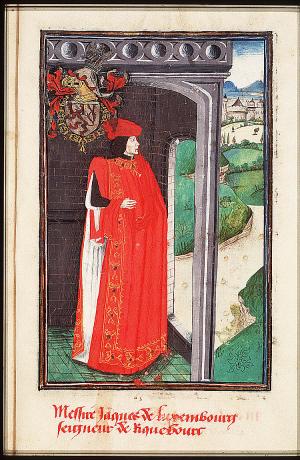
Jacques de Luxembourg, Seigneur de Richebourg was a French noble who served Charles the Bold, Duke of Burgundy and later King Louis XI of France.

















